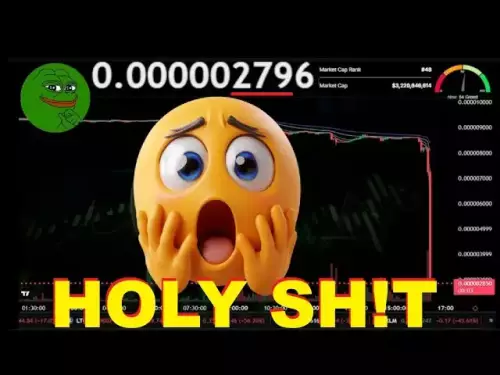-
 bitcoin
bitcoin $111375.742210 USD
-8.60% -
 ethereum
ethereum $3780.311592 USD
-13.98% -
 tether
tether $1.001299 USD
0.07% -
 bnb
bnb $1093.375857 USD
-13.01% -
 xrp
xrp $2.339375 USD
-16.91% -
 solana
solana $185.029017 USD
-16.69% -
 usd-coin
usd-coin $1.000230 USD
0.04% -
 tron
tron $0.319531 USD
-5.16% -
 dogecoin
dogecoin $0.190791 USD
-23.59% -
 cardano
cardano $0.638663 USD
-21.82% -
 ethena-usde
ethena-usde $0.998483 USD
-0.20% -
 hyperliquid
hyperliquid $37.741486 USD
-14.68% -
 chainlink
chainlink $17.229851 USD
-22.17% -
 stellar
stellar $0.316546 USD
-16.74% -
 bitcoin-cash
bitcoin-cash $507.861193 USD
-13.18%
A complete guide to cryptocurrency investment from tiny principal to huge returns
Start small in crypto with a tiny principal; use DCA, diversify, and research to aim for huge returns. Secure your investments and stay informed.
May 29, 2025 at 07:56 am

Investing in cryptocurrencies can be an exciting journey, especially when starting with a tiny principal and aiming for huge returns. This guide will walk you through the entire process, from understanding the basics to advanced strategies that can help you maximize your investments. Whether you're new to the crypto world or looking to refine your investment approach, this comprehensive guide will provide you with the knowledge and tools needed to succeed.
Understanding Cryptocurrency Basics
Before diving into investment strategies, it's crucial to understand the fundamentals of cryptocurrencies. Cryptocurrencies are digital or virtual currencies that use cryptography for security. Bitcoin, launched in 2009, was the first cryptocurrency and remains the most well-known. Since then, thousands of other cryptocurrencies have emerged, each with its own unique features and purposes.
To start investing, you need to familiarize yourself with key terms such as blockchain, the underlying technology that enables secure, decentralized transactions; wallets, where you store your cryptocurrencies; and exchanges, platforms where you can buy, sell, or trade cryptocurrencies. Understanding these basics will provide a solid foundation for your investment journey.
Setting Up Your Investment
Starting with a tiny principal requires careful planning and strategy. The first step is to choose a reliable cryptocurrency exchange. Popular options include Coinbase, Binance, and Kraken. Each exchange has its own set of features, fees, and supported cryptocurrencies, so it's important to research and select the one that best fits your needs.
Once you've chosen an exchange, you'll need to create an account. This typically involves providing your email address, creating a password, and verifying your identity through a process known as Know Your Customer (KYC). After your account is set up, you can deposit funds into your exchange account using various methods such as bank transfers, credit/debit cards, or even other cryptocurrencies.
Developing Your Investment Strategy
With your exchange account funded, the next step is to develop a strategy that aligns with your investment goals and risk tolerance. One common approach is dollar-cost averaging (DCA), where you invest a fixed amount of money at regular intervals, regardless of the market's performance. This strategy can help reduce the impact of volatility and is particularly suitable for those starting with a tiny principal.
Another strategy is diversification, which involves spreading your investments across different cryptocurrencies to mitigate risk. Instead of putting all your money into one cryptocurrency, consider investing in a mix of established coins like Bitcoin and Ethereum, as well as smaller, high-potential altcoins.
Researching and Selecting Cryptocurrencies
To achieve huge returns, it's essential to conduct thorough research before selecting which cryptocurrencies to invest in. Start by analyzing market trends and reading whitepapers, which provide detailed information about a cryptocurrency's technology, goals, and roadmap. Additionally, following crypto news and joining online communities can help you stay informed about the latest developments and potential investment opportunities.
When selecting cryptocurrencies, consider factors such as market capitalization, trading volume, and use case. Cryptocurrencies with a strong use case and growing adoption are more likely to experience long-term growth. For example, Ethereum is widely used for decentralized applications and smart contracts, making it a popular choice for many investors.
Managing and Growing Your Portfolio
Once you've invested in your chosen cryptocurrencies, it's important to monitor and manage your portfolio regularly. Use tools such as portfolio trackers to keep track of your investments and their performance. These tools can provide valuable insights into your portfolio's overall health and help you make informed decisions about when to buy, sell, or hold.
To grow your portfolio, consider reinvesting your profits. Instead of cashing out your gains, you can use them to purchase more cryptocurrencies, thereby compounding your returns over time. Additionally, staying updated on market trends and adjusting your strategy as needed can help you capitalize on new opportunities and minimize potential losses.
Advanced Strategies for Huge Returns
For those looking to maximize their returns, advanced strategies such as trading and yield farming can be effective. Trading involves buying and selling cryptocurrencies to take advantage of short-term price movements. This can be done through day trading, where you buy and sell within the same day, or swing trading, where you hold positions for several days or weeks.
Yield farming, on the other hand, involves lending your cryptocurrencies to decentralized finance (DeFi) platforms in exchange for interest or other rewards. This strategy can provide passive income and potentially high returns, but it also comes with higher risks, so it's important to do your due diligence before participating.
Security and Risk Management
Investing in cryptocurrencies comes with inherent risks, so it's crucial to prioritize security and risk management. Use strong passwords and enable two-factor authentication (2FA) on your exchange accounts to protect against unauthorized access. Additionally, consider using hardware wallets for storing your cryptocurrencies offline, as they offer a higher level of security compared to software wallets.
To manage risk, set stop-loss orders to automatically sell your cryptocurrencies if their price drops to a certain level. This can help limit potential losses. Additionally, avoid investing more than you can afford to lose and stay informed about regulatory changes that could impact the crypto market.
FAQs
Q: Can I start investing in cryptocurrencies with just a few dollars?A: Yes, many exchanges allow you to start investing with as little as a few dollars. Platforms like Coinbase and Binance offer low minimum deposit requirements, making it accessible for those with a tiny principal.
Q: How often should I check my cryptocurrency investments?A: It's a good idea to check your investments regularly, but the frequency depends on your strategy. If you're a long-term investor, checking weekly or monthly may be sufficient. For active traders, daily or even hourly monitoring might be necessary.
Q: Are there any tax implications when investing in cryptocurrencies?A: Yes, there can be tax implications depending on your country of residence. In many jurisdictions, cryptocurrencies are treated as property, and you may be required to report capital gains or losses. It's advisable to consult with a tax professional to understand your specific obligations.
Q: What should I do if I suspect my cryptocurrency account has been compromised?A: If you suspect your account has been compromised, act quickly. Immediately change your password, enable 2FA if you haven't already, and contact the exchange's support team. If funds have been stolen, report the incident to the appropriate authorities and consider moving your remaining cryptocurrencies to a new, secure wallet.
Disclaimer:info@kdj.com
The information provided is not trading advice. kdj.com does not assume any responsibility for any investments made based on the information provided in this article. Cryptocurrencies are highly volatile and it is highly recommended that you invest with caution after thorough research!
If you believe that the content used on this website infringes your copyright, please contact us immediately (info@kdj.com) and we will delete it promptly.
- Bittensor (TAO): Super Bullish Signals Point to Potential 2x Rally
- 2025-10-11 10:25:12
- Silver Price Correction: Navigating the Dip & Identifying Key SEO Keywords
- 2025-10-11 10:25:12
- MoonBull: The Crypto Meme Coin Promising 1000x Gains?
- 2025-10-11 10:30:01
- Crypto Payroll Revolution: Stablecoins, Altcoins, and the Future of Salary Payments
- 2025-10-11 10:30:01
- Decoding Crypto Trends: XRP's Bitcoin Dream, BlockDAG's Rise, and the PayFi Revolution
- 2025-10-11 10:30:01
- Amina Bank & Polygon: Institutional Staking with a Sweet 15% Yield
- 2025-10-11 10:30:15
Related knowledge

Practical parameter settings for a Bitcoin multi-timeframe moving average system
Sep 18,2025 at 10:54pm
Optimizing Timeframe Combinations for Bitcoin Trading1. Selecting appropriate timeframes is crucial when building a multi-timeframe moving average sys...

How can I filter out false breakouts in Dogecoin high-frequency trading?
Sep 22,2025 at 01:00am
Understanding False Breakouts in Dogecoin Trading1. A false breakout occurs when Dogecoin's price appears to move beyond a defined support or resistan...

Techniques for identifying tops and bottoms in the Bitcoin on-chain NVT model
Sep 20,2025 at 07:54pm
Understanding the NVT Model in Bitcoin Analysis1. The Network Value to Transactions (NVT) ratio is often described as the 'P/E ratio' of the cryptocur...

What does the surge in open interest in Bitcoincoin futures mean?
Sep 20,2025 at 11:18pm
Understanding the Surge in Dogecoin Futures Open Interest1. A surge in open interest within Dogecoin futures indicates a growing number of active cont...

How can I use the Ethereum USDT premium to gauge market sentiment?
Sep 18,2025 at 11:55pm
Understanding the Ethereum USDT Premium1. The Ethereum USDT premium refers to the price difference between USDT (Tether) traded on Ethereum-based plat...

What should I do if Ethereum staking yields decline?
Sep 20,2025 at 06:18am
Understanding the Causes Behind Declining Ethereum Staking Yields1. The Ethereum network transitioned to a proof-of-stake consensus mechanism with the...

Practical parameter settings for a Bitcoin multi-timeframe moving average system
Sep 18,2025 at 10:54pm
Optimizing Timeframe Combinations for Bitcoin Trading1. Selecting appropriate timeframes is crucial when building a multi-timeframe moving average sys...

How can I filter out false breakouts in Dogecoin high-frequency trading?
Sep 22,2025 at 01:00am
Understanding False Breakouts in Dogecoin Trading1. A false breakout occurs when Dogecoin's price appears to move beyond a defined support or resistan...

Techniques for identifying tops and bottoms in the Bitcoin on-chain NVT model
Sep 20,2025 at 07:54pm
Understanding the NVT Model in Bitcoin Analysis1. The Network Value to Transactions (NVT) ratio is often described as the 'P/E ratio' of the cryptocur...

What does the surge in open interest in Bitcoincoin futures mean?
Sep 20,2025 at 11:18pm
Understanding the Surge in Dogecoin Futures Open Interest1. A surge in open interest within Dogecoin futures indicates a growing number of active cont...

How can I use the Ethereum USDT premium to gauge market sentiment?
Sep 18,2025 at 11:55pm
Understanding the Ethereum USDT Premium1. The Ethereum USDT premium refers to the price difference between USDT (Tether) traded on Ethereum-based plat...

What should I do if Ethereum staking yields decline?
Sep 20,2025 at 06:18am
Understanding the Causes Behind Declining Ethereum Staking Yields1. The Ethereum network transitioned to a proof-of-stake consensus mechanism with the...
See all articles


























![Internet Computer Price Prediction [ICP Crypto Is A Hold?] Here’s Why Internet Computer Price Prediction [ICP Crypto Is A Hold?] Here’s Why](/uploads/2025/10/11/cryptocurrencies-news/videos/internet-computer-price-prediction-icp-crypto-hold/68e9ac40cf659_image_500_375.webp)















































